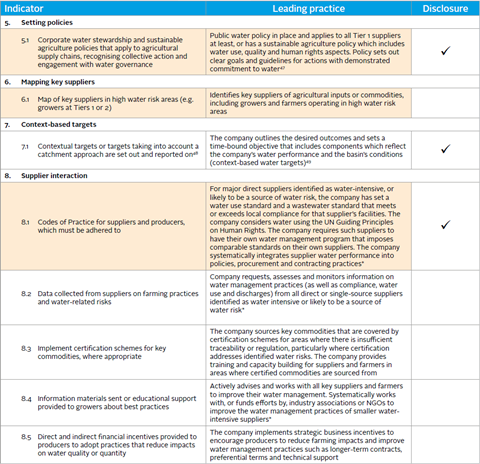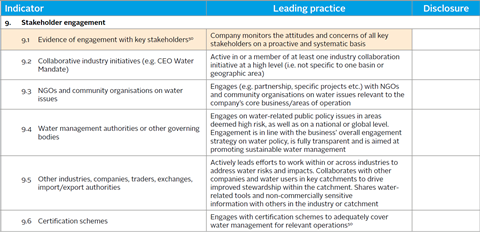Once a company’s water impacts and risks are understood, a response and risk mitigation strategy should be developed and implemented.
Action within the company’s own operations is an easy first step, such as outlining targets and plans. It can also boost awareness through the company. Water efficiency and accounting, reporting on water quantity and quality, and a reduction of pollution are all potential aspects of internal action. Targets should be set at the site level and account for the water scarcity and water quality circumstances in the catchments in which they are located, and should reflect the size and influence of the business.
Companies should begin to engage their suppliers through conferences, dialogues and contracting processes, and assess how they can take action. For example, companies with direct relationships with growers will find it easier to engage them on water issues compared to those sourcing traded commodities. This is a critical stage for companies with higher indirect water use (via their supply chain) than through their direct operations. External stakeholder engagement throughout all elements is important as information received from different organisations may influence policies and processes to manage agricultural supply chain water risk.
Investors expect companies to:
- establish a corporate water stewardship policy and implementation plan, including goals with time-bound, contextual targets, actions to mitigate water risks in the supply chain and a monitoring and evaluation plan;
- cover water issues comprehensively, including water governance, water consumption, water quality, and freshwater habitats/special cultural areas;
- identify key suppliers that can be influenced at the grower level (e.g. where growers are at Tier 1 or Tier 2 of the supply chain);
- for commodity supply chains, ensure that, where applicable/required, these are certified to recognised standards (e.g. Better Cotton Initiative, Roundtable on Responsible Soy, Roundtable on Sustainable Palm Oil, Bonsucro, Rainforest Alliance);
- ensure suppliers are at least fully compliant with relevant local legislation. For countries where legislation and regulation is poor, external certification, standards and auditing should be the baseline;
- share lessons from water projects with all relevant suppliers; and
- implement procurement standards, incentives and awareness programmes to encourage suppliers to mitigate water risks.
Example engagement questions
- Do you have a corporate-level water stewardship or sustainable agricultural policy that robustly addresses water?
- Do you know who your key growers are?
- Do you have purchasing power influence on them (i.e. are you a relatively big buyer from them)?
- Do your water goals and targets account for context? How?
- Do you set standards for the growers that you source from and verify compliance?
- Is this only at Tier 1 in your supply chain, Tier 2 etc.?
- How do you monitor the actions taken by suppliers?
- If you employ standards for sourcing commodities, do they cover the relevant water risks facing those commodities in the locations you source them from?
- How do you disseminate the results or outcomes of any best practice projects with the rest of your supply chain?
- Do you offer incentives to encourage supplier best practice on water and soil management (e.g. preferential terms, longer-term contracts and technical support)? If so, what are they?
- What engagement do you have with traders, exchanges, import/export authorities, etc. on their role in improving traceability and standards for commodity production?
- Are you active in or a member of collaborative industry initiatives focused on water?
Good practice example: Diageo
Diageo has developed a Water Blueprint, which sets out its strategy to understand the impact on water through the whole value chain and to respond appropriately. The company recognises the impact of water use by agricultural suppliers, and encourages improved water stewardship among key suppliers, including through:
- ensuring sustainable water stewardship practices are employed where Diageo has operational control of agricultural land; and
- reducing environmental impact and improving livelihoods in the communities where Diageo sources from, using its agronomic advisory services and Sustainable Agriculture Guidelines to encourage sustainable agriculture practices.
Diageo also encourages key suppliers to report water use, risks and management, and drive improved performance and impact reduction Through CDP fs Supply Chain Water Programme. Diageo requests its largest suppliers to disclose their water management practices and aims to better understand the impact of its supply chain on water and to directly support suppliers with a comprehensive water stewardship guide.
Download the full report
-

Investor guide on water risks in agricultural supply chains
March 2018
Growing water risk resilience: an investor guide on agricultural supply chains
- 1
- 2
- 3
- 4
- 5
- 6Currently reading
Promote internal and supply chain action
- 7
- 8
- 9
- 10
- 11
- 12
- 13
- 14
- 15
- 16
- 17
























